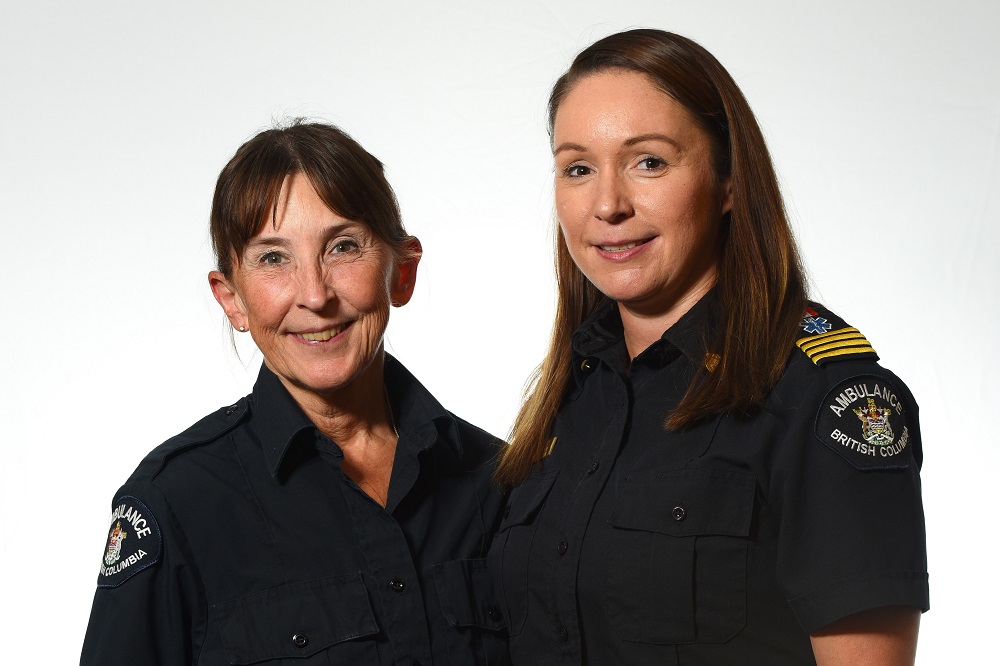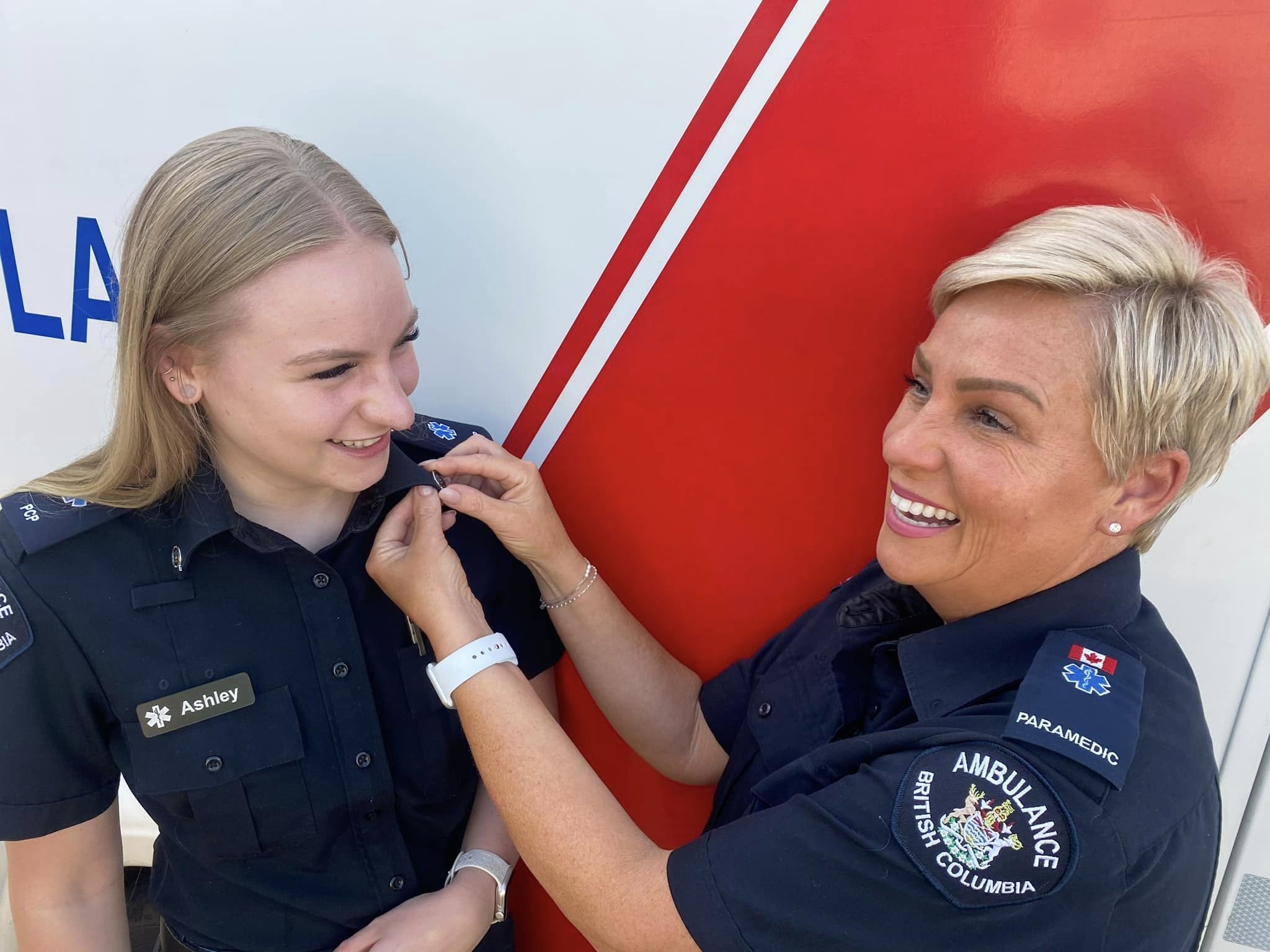by Karla Wilson
A 2016 study published in
The Journal of Neuroscience shows the relationship between mothers and daughters is the strongest of all parent-child bonds. It stands to reason, then, that when a daughter witnesses the real difference her mom makes in the world with her chosen career, it’s no surprise she might choose to follow the same path. BC Emergency Health Services is home to a number of mother-daughter pairs who work together.
As part of our “50 stories for 50 Years” celebration of our amazing employees past and present, we recently spoke with two of these incredible duos.
***
Dispatch Supervisor Natalie Rumsby from the Langford Dispatch Operations Centre (LDOC) in Victoria comes from a family steeped in paramedicine. Both her parents and brother are paramedics, and her husband works with her as a charge dispatcher.
“Every family vacation we went on when I was growing up was delayed by stopping at a car accident,” Natalie says. “Sometimes my dad would transport a patient to the hospital with the paramedics who would arrive on the scene, or we’d all be waiting for a helicopter to be brought in. I remember a couple of times where my parents would be giving treatment on the side of the road, and I’d be helping splint a limb.”
While it wasn’t the average childhood experience, Natalie and her siblings benefitted from watching their parents care for others. Natalie started her own paramedicine career with BCEHS in 2002.
“When I started it was far more male-dominated,” Natalie recalls. “There were some unique challenges being a woman. The equipment wasn’t built for lifting patients safely and I used to stand on my tiptoes to lift the cot into the ambulance. But we’ve progressed a lot as a service with new equipment and policies.”
After three years working as a paramedic, Natalie moved to Dispatch Operations. Natalie’s mother, Sheree Hunt, had already transferred from working on an ambulance to working as an Emergency Medical Dispatcher (EMD) at the same dispatch centre, and the two started working side-by-side.
.jpg?RenditionID=3)
Sheree Hunt with daughter Natalie Rumsby on the day Natalie was signed off as an Emergency Medical Dispatcher in 2005
Natalie’s arrival at dispatch also signalled a broader change that was taking place within the organization. When Sheree first started in dispatch in 1989, she was one of only two women on the dispatch floor.
“Back then it was a feeling of ‘suck up your emotions, you don’t have feelings’,” Sheree recalls. “There were a lot of male egos to bump heads with and work around. But it was okay, as long as you did your job well. When Natalie joined, she had a few battles to fight on her own that she had to handle, too. I could give her advice based on what I experienced.”
While raising their young family, Hunt and her paramedic husband were able to coordinate their schedules so that someone was always home with their three children. And while household labour statistics are now shifting closer to 50/50 for Canadian families according to Statistics Canada, this wasn’t the case while Sheree was raising her kids.
“Like most women, I did the majority of stuff around the house,” Sheree says. “My husband was a big help but the organizing and figuring out of things usually fell to me. I always managed to arrange my shifts with lots of time to do things with the kids and we always stayed active in everything.”
“My mom had to juggle a huge workload,” Natalie recalls. “Not only the workload of shiftwork, stress, and getting adequate rest, but then the added mental workload on top of that. She was commuting to Victoria (from Duncan) and would then come home and have to think about making dinner for the family. I can appreciate it a lot more now.”
As more women take on roles in emergency medicine, Natalie says there is a special skill set that women bring to the job.
“We can approach situations with care and empathy. We’re still able to be firm and assertive. I don’t have kids but it’s how I imagine it must be like to be a mom. You have to stand firm on those rules but still be compassionate. I think it’s a unique skill set that a lot of women bring to the profession.”
Sheree, first a paramedic then an EMD, worked for 35 years at BCEHS before retiring in the spring of 2019. Over the years, she has seen a vast change in the organization, with women now making up more than half of all staff at LDOC — and 43% across the organization in unionized roles such as paramedics and dispatchers.
Although officially retired from her role as an Emergency Medical Dispatcher, Sheree continues to work one shift every Friday at LDOC — sometimes with Natalie as her supervisor. The two share a close bond and text each other every night, even if they see each other at work.
“I enjoy working with her and we work well as a team,” Sheree says. “It’s just she’s now my boss. So, while she’s the boss of me at work, I’m the boss of her still at home.”
 Pictured L to R: Sheree Hunt with daughter Natalie Rumsby in 2023 ---
Pictured L to R: Sheree Hunt with daughter Natalie Rumsby in 2023 ---
New paramedic Ashley Fell of Surrey, BC also grew up with a mother who worked in pre-hospital care. Her mother, Stacy Elliott, has been a paramedic with BCEHS for 30 years. Stacy proudly ‘pinned’ her youngest child as a Primary Care Paramedic in July 2024.

Stacy Elliott proudly pinning daughter Ashley Fell with her Primary Care Paramedic pin in July 2024
“It was exciting and really surreal,” Stacy says of the occasion. “I never thought she’d be working for BCEHS. It was emotional and such a feeling of accomplishment for both of us.”
Stacy joined BCEHS in 1994 and started her career in Lytton, BC at the age of 19. At the time, female paramedics were a rarity.
“I worked at a station with all men, and it took a long time before I started to see more women interested in the profession,” she says. “It was a different feeling being at work and difficult at times. I had patients who refused my service because I was a woman.”
30 years later, Ashley hasn’t had the same experience.
“I had a lot of female preceptors, which was awesome,” Ashley says of the women who helped mentor her as she earned her primary care paramedic designation. “Honestly, it’s not really thought about. Both genders do this job and it’s totally normalized now.”
And while shiftwork doesn’t always bring work-life balance to mind, Stacy says working part-time as a paramedic gave her exactly what she needed to raise her four girls while her husband focused on his small business. When Ashley was diagnosed with Type 1 diabetes at the age of eight, Stacy says the flexibility allowed her to take her daughter to appointments and look after her.
“BCAS gave me the flexibility to have a great job and a career but also able to choose my own days and hours,” she says.
As for Ashley, her diagnosis helped to solidify her future career path.
“I knew I wanted to work in healthcare after being diagnosed,” she says. So, after graduating high school, Ashley earned her Emergency Medical Responder qualification and went on to become a Primary Care Paramedic.
Like any mother, Stacy is protective of her daughter, and she is excited to see her thrive. She feels an immense pride in where the organization has come from in terms of its mental supports for employees.
“I can’t tell you how far BCAS has come within 30 years. The changes that I’ve seen and support systems we have in place now are unbelievable,” she says. “Before, it was sort of thought if you weren’t strong enough to handle the calls then maybe you should find a new job. Now, if you do a bad call, you have so many resources to protect you so you don’t get to burnout.”
Along with these resources, Ashley says having a mom as a paramedic has been invaluable support to her as she embarks on her new career.
“You need your support network around you. So, when I come home and want to talk about something – she gets it. So, mom has been a really good resource to have,” Ashley says.
Both women are enthusiastic about their jobs – so much so, their positivity is contagious. Despite years of experience, Stacy raves about the role.
“I still love the job so much – and I do it because I love it,” Stacy says. “I’ll often come home and say: ‘I can’t believe they paid me money to do this today.’”
Ashley echoes her mother’s sentiments: “I love it. So far, I’m having a great time. When I get to work with my friends, I feel like I’m not really going to work. I can see myself doing this for quite a long time and sticking with it.”
As of the publishing of this article, Stacy and Ashley have worked four paramedic shifts together in the same ambulance.
“We just have one rule when we’re working together,” Stacy says. “She can’t call me ‘mom’.”
Are you part of a family working at EHS? If so, we'd love to hear from you:
Nicholas.Hume@bcehs.ca.

